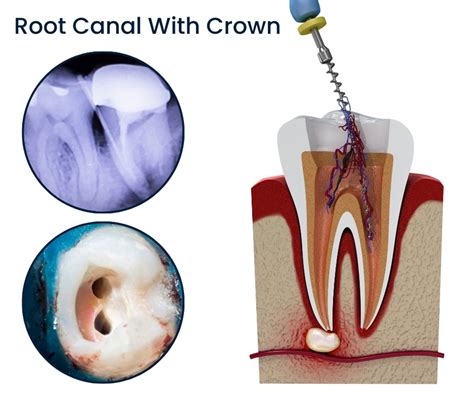Root Canal to Crown: Minimizing Discomfort & Maximizing Results
A root canal, followed by a crown, is a common procedure designed to save a severely damaged tooth. While essential for preserving your natural teeth, the process can understandably raise concerns about discomfort and recovery. This comprehensive guide explores the root canal to crown procedure, focusing on minimizing discomfort and maximizing the longevity of your restored tooth. We'll delve into the intricacies of each stage, offering practical advice and answering frequently asked questions.
Understanding the Root Canal to Crown Process
The journey from a damaged tooth to a fully restored one involves two distinct yet interconnected procedures:
1. Root Canal Treatment: This procedure addresses the infected pulp (the soft tissue inside your tooth) by removing it, cleaning the canals, and sealing them to prevent further infection. The goal is to save the tooth structure, preventing extraction. Modern techniques utilize local anesthesia to ensure minimal pain during the procedure.
2. Crown Placement: Once the root canal is complete, the tooth is often weakened and requires a crown for protection and structural integrity. A crown is a cap that fits over the remaining tooth structure, restoring its shape, strength, and function. Several materials, including porcelain, ceramic, and metal alloys, are available depending on your needs and aesthetic preferences.
What to Expect During a Root Canal
Many patients fear the pain associated with root canals. However, modern techniques and advancements in anesthesia significantly reduce discomfort. You'll likely experience:
- Local Anesthesia: A local anesthetic will numb the area, eliminating pain during the procedure.
- Minimal Discomfort: While you may feel some pressure, significant pain is uncommon. Your dentist will monitor your comfort level throughout.
- Post-Procedure Sensitivity: Some mild sensitivity or discomfort may occur after the root canal, but this is usually manageable with over-the-counter pain relievers.
What to Expect After a Root Canal
Post-root canal care is crucial for a successful outcome. Following your dentist's instructions carefully will minimize discomfort and complications. You can expect:
- Temporary Filling: Your tooth will be temporarily filled after the root canal. This protects the cleaned canals until the crown is placed.
- Sensitivity: Some teeth experience temporary sensitivity to hot or cold temperatures. This usually subsides within a few weeks.
- Slight Swelling: Minor swelling is possible, but it usually resolves quickly.
Why is a Crown Necessary After a Root Canal?
A root canal treatment leaves the tooth structurally weaker. The pulp's removal compromises the tooth's ability to withstand biting forces. A crown provides:
- Protection: Shields the tooth from further damage and fracture.
- Restoration: Restores the tooth's natural shape and function.
- Strength: Enhances the tooth's ability to withstand chewing pressure.
- Improved Aesthetics: Provides a natural-looking restoration, blending seamlessly with your other teeth.
How to Minimize Discomfort During and After the Procedure
Several strategies can help minimize discomfort:
- Communicate with Your Dentist: Discuss any anxieties or concerns you have before the procedure. Your dentist can address your questions and alleviate fears.
- Follow Post-Operative Instructions: Meticulously follow your dentist's instructions regarding pain medication, oral hygiene, and dietary restrictions.
- Maintain Good Oral Hygiene: Brush and floss gently around the treated tooth, avoiding excessive pressure.
- Avoid Chewing on the Treated Tooth: Allow the tooth adequate time to heal before resuming normal chewing habits.
What are the risks associated with root canal and crown treatment?
While generally safe, root canal and crown procedures carry potential risks, including:
- Infection: Although rare with proper treatment, infection can occur.
- Crown Fracture: A crown can fracture due to trauma or excessive biting forces.
- Root Canal Failure: In some cases, root canal treatment may fail, requiring further intervention.
How long does the entire procedure take?
The time required for the entire process varies depending on the complexity of the root canal and the type of crown used. Root canal treatment can take one to several appointments, while crown placement usually requires one to two additional appointments.
How much does a root canal and crown cost?
The cost of a root canal and crown varies widely depending on factors like geographic location, the dentist's fees, and the type of crown chosen. It’s essential to discuss costs with your dentist beforehand to ensure you understand the financial implications.
Conclusion
Undergoing a root canal and crown procedure doesn't have to be a daunting experience. By understanding the process, communicating openly with your dentist, and following post-operative instructions carefully, you can minimize discomfort and maximize the chances of a successful, long-lasting outcome. Remember that preserving your natural teeth is a significant investment in your long-term oral health.

